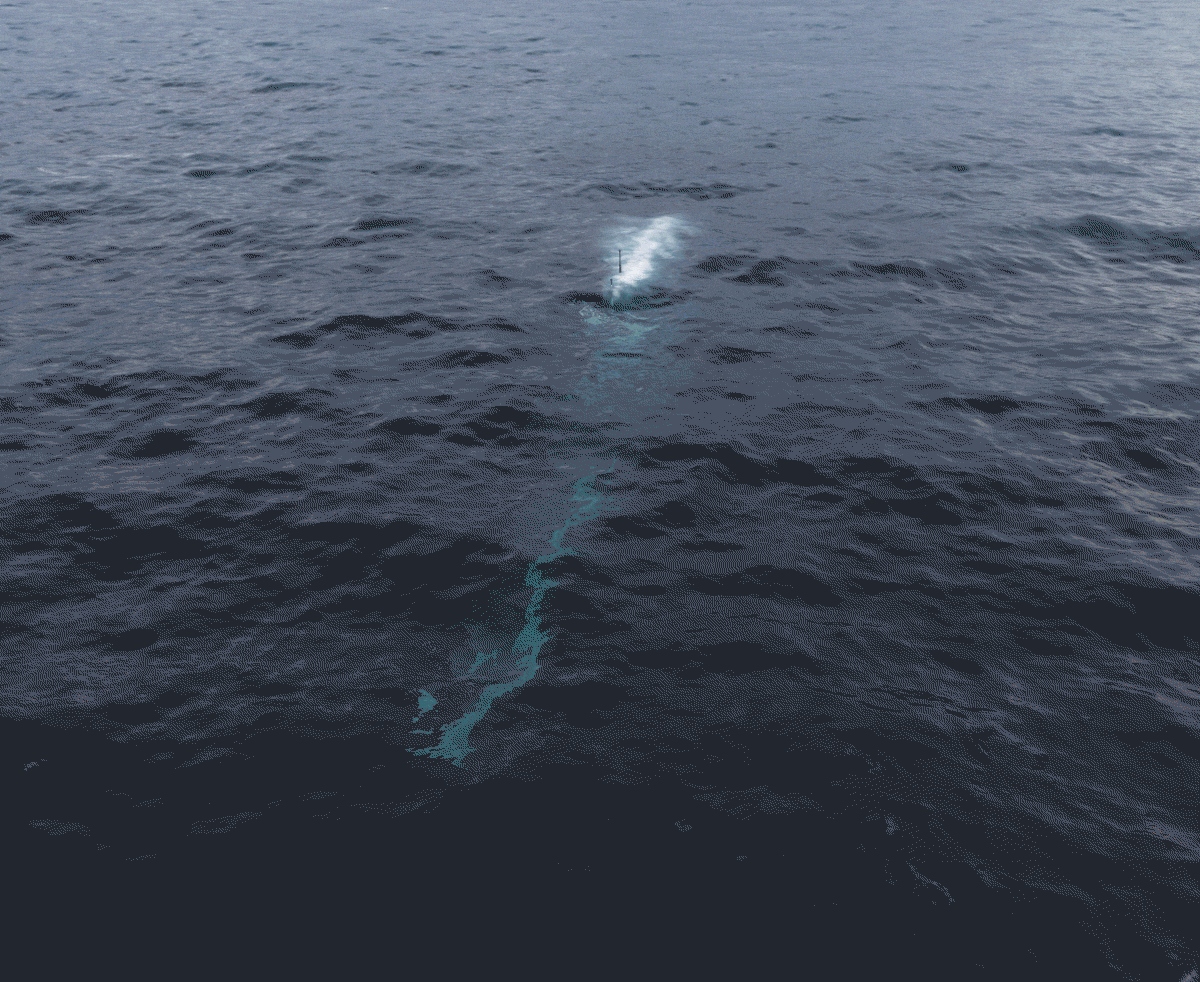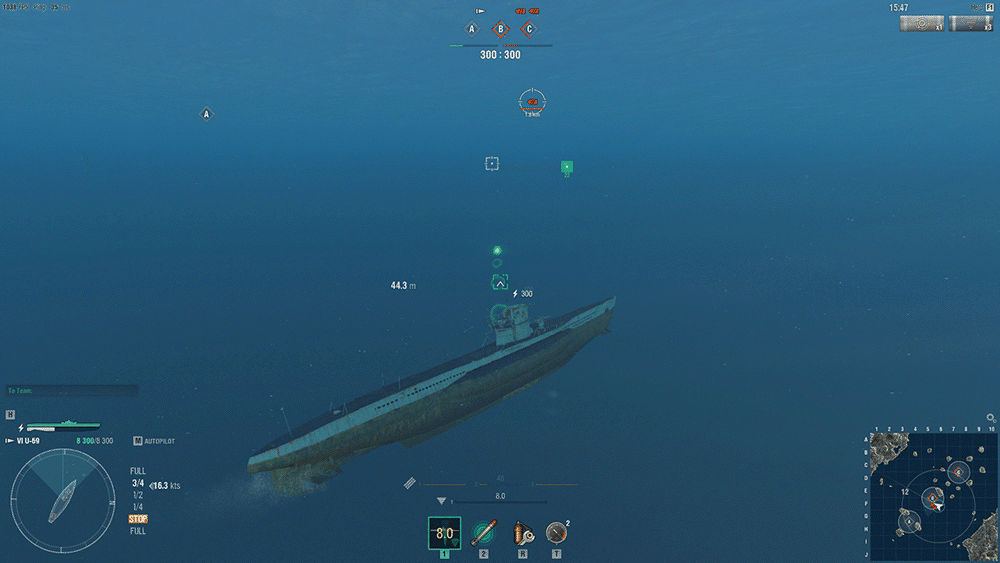
Featured Blog | This community-written post highlights the best of what the game industry has to offer. Read more like it on the Game Developer Blogs.
Introducing Submarines into World of Warships: How to Balance Fun Gameplay Against Realism
Adding a brand new class to a game 5 years after its release isn’t an easy task at all. As Executive Producer, id like to submerge developers and players into our experience of making submarines, and the hurdles we overcame.

There’s a ship type that has been missing World of Warships so far—submarines. Our players have been asking us about them since the game's Alpha Test back in 2015, and although, historically, submarines hardly took any part in battles – instead primarily waging a hidden war of attrition upon enemy supply lines – we decided to add them to the game.
But adding a new ship type to the game 5 years after its release isn’t an easy task at all.
As Executive Producer, I’m happy to share our experience of working on submarines, and I hope that it will be both useful to other developers and interesting to our players.
The Silent Hunter game series, the film Das Boot, autobiographical books, and other works have firmly shaped the image of submarines in popular culture. A tiny, tightly packed boat posing a lethal threat to both the enemy and her crew, the heart-pounding observation of a target through the periscope, the calculation of a torpedo attack, the rumbling explosions of depth charges—all of these scenarios are deeply anchored in the minds of naval history aficionados when they think about submarines.

World of Warships is the studio’s largest project and until now, we’ve kept the bar high in making it the best fleet action game, updating the game monthly and continually adding a huge amount of content, both in scope and depth, to keep the audience excited at all times.
At the very heart of the gameplay is a system of ship types that are effectively our game classes, all of which play completely differently from each other. This is what makes World of Warships so versatile. Realism is central to our game’s DNA - our ship types are based on real-life ships that were in service in the world's Navies around the time of the First and Second World Wars. In order to balance gameplay, destroyers, battleships, cruisers, and aircraft carriers fight on equal terms. Each possesses their specific strengths and weaknesses, just like their real-life counterparts, that were built and used for very specific purposes.
“Our task was to find the sweet spot in the middle…”
Our first playable submarine prototype was released as part of the 2018 PvE Halloween event. Submarines could submerge and resurface, oxygen mechanics were implemented, and depth charges could be launched. The event confirmed that the topic still raised extreme excitement among players, and the type could fit into the game. However, it was clearly not enough, and there were many problems that required resolutions.
 Firstly, those prototype submarines played the part of some sort of invisible assassins, constantly jumping out from the dark, unleashing surprise attacks upon startled enemies, and disappearing from sight again. It was fun, no doubt, but, firstly, it didn't convey that very submarine-specific atmosphere from books and films, and secondly, it wasn't very fair from other players' perspectives.
Firstly, those prototype submarines played the part of some sort of invisible assassins, constantly jumping out from the dark, unleashing surprise attacks upon startled enemies, and disappearing from sight again. It was fun, no doubt, but, firstly, it didn't convey that very submarine-specific atmosphere from books and films, and secondly, it wasn't very fair from other players' perspectives.
 Therefore, we approached the development of the current version of submarines with two opposing references to hand: the real-life behavior of submarines, with very slow and rigorous processes, vs. the fun, fast scuffle of the Halloween PvE event. Our task was to find the sweet spot in the middle: to create the right atmosphere and reduce the excessively dashing pace of the game, but at the same time not to lose the overall dynamics.
Therefore, we approached the development of the current version of submarines with two opposing references to hand: the real-life behavior of submarines, with very slow and rigorous processes, vs. the fun, fast scuffle of the Halloween PvE event. Our task was to find the sweet spot in the middle: to create the right atmosphere and reduce the excessively dashing pace of the game, but at the same time not to lose the overall dynamics.
The Nitty-gritty of Balancing
We are about to enter test iteration 4, and quite a bit has changed since the original conception of submarines. Only through the testing phases, they have gained traits of a fully-fledged new class with their own unique features. Here are a few of the challenges we have faced in this time:
Movement Speed

(Gif not representative of in-game movement speed.)
The main challenge that had to be resolved by our game designers was the fact that submarines weren’t designed for fleet battles. Also, in reality, submarine operations could take days or weeks, whereas we needed to make this class type relevant for an action-packed battle lasting around 20 minutes. An obvious measure was to significantly increase the submarine’s dynamics and speed. You can't turn days into minutes otherwise. On the other hand, the measure isn’t entirely new for the game—all of our ships' speed characteristics are often higher than those of their real-life counterparts.
Torpedoes
 A curious factor about torpedoes came up: their actual cruising depth used to be rather irrelevant to the eventual impact. In simple terms, most torpedoes in our game could hit any ship unlucky enough to be in their way, with only a few special deep-water torpedoes being unable to hit certain types of ships (for example, we have torpedoes that can never hit destroyers and just pass underneath them).
A curious factor about torpedoes came up: their actual cruising depth used to be rather irrelevant to the eventual impact. In simple terms, most torpedoes in our game could hit any ship unlucky enough to be in their way, with only a few special deep-water torpedoes being unable to hit certain types of ships (for example, we have torpedoes that can never hit destroyers and just pass underneath them).

The system seemed fine and was quite easy for players to understand. But a submarine is a whole different story—she can change her depth. Therefore, especially for this new type, we've introduced realistic torpedo collisions in 3D.
Hydro shock
 For high-explosive shells, bombs, and rockets, we've made an additional splash that affects only submarines and has a wider area of effect. Firstly, this conveys the phenomenon of hydro shock, when a submarine can be damaged by a nearby explosion, and secondly, it increases the risks for a submarine when she’s detected, helping others to counteract her.
For high-explosive shells, bombs, and rockets, we've made an additional splash that affects only submarines and has a wider area of effect. Firstly, this conveys the phenomenon of hydro shock, when a submarine can be damaged by a nearby explosion, and secondly, it increases the risks for a submarine when she’s detected, helping others to counteract her.
Introduction of Sonar Pings for Torpedo Launching
Instead of the previous torpedo launch scheme, which can be briefly described as “aim—shoot—get out,” we've added the active sonar mechanics.

These motivate players to keep track of the target through the periscope after launching torpedoes and to continuously interact with the enemy ship by “hitting” her with sonar pings. The sonar ping mechanics aren't imperative, but not utilizing them during a torpedo attack will be extremely ineffective. These mechanics are very important because:
They create that very atmosphere of “observing a target through the periscope” and, in a way, emulate the hours of intense work done by submariners before and during an attack.
They lead to understandable risks and potential counterplay—each time a sonar ping is emitted, the position of the submarine is shown to enemies on their Minimaps, as well as increasing their detectability range, especially on the surface level.
They bring in the "risk vs. reward" dilemma. One ping hitting a ship slightly guides torpedoes to their target, whereas a second successful ping makes the torpedoes dive deeper and explode under the bottom of the ship, causing more damage to the enemy. However, keep in mind each emitted ping is an obvious invitation to the enemy to deal with the submarine. By the way, torpedoes being guided to their target isn’t just a work of fiction—such weapons really existed.

Vertical Steering System
Many players remembered that they were able to change their submarine’s depth to predetermined levels in the 2018 PvE Halloween event 'Terror of the Deep', and one of the most frequent items of feedback left by testers during the first iteration was the desire to have full control over a submarine’s depth.

We took this feedback on board and now the player can choose between two modes while using manual depth control:
Surface level, which allows for relatively high speed, increased base detectability and high risk of being spotted when emitting sonar pings.
Underwater level, which starts at a depth of 6 meters, players can dive freely up or down to their liking. The speed there is greatly restricted, but base detectability is low and emitting sonar pings is safe.
Out with the Oxygen Supply and in with Battery Power Mechanics
We’ve removed the oxygen supply mechanic entirely, instead opting for battery power that is used up when emitting sonar pings, or when traveling at high speeds. Battery power can be replenished when traveling at much slower speeds (¼ total speed), or when the submarine is at periscope depth. If the player is out of battery power, they cannot emit sonar pings, reducing their combat effectiveness.

A submarines requirement for battery power to remain effective at sea is still historically accurate, but using this mechanic over the oxygen supply allows us to penalize players for abusing sonar pings, forcing them to carefully consider their plan of attack, and limiting their movements.
Power Creeping on Existing Classes
Although the mechanics were quite good, and submarines were indeed very effective against battleships, after the test we realized the following: battleships were suffering from too much damage, while submarines themselves were almost helpless against cruisers and destroyers. As a result, we’ve redistributed the damage stats, and now “basic” submarine torpedoes deal greater damage, while torpedoes successfully “guided” by two sonar pings deal less damage.
.jpeg?width=700&auto=webp&quality=80&disable=upscale)
Additionally, the second successful hit with a sonar ping will increase the accuracy of torpedo guidance, giving players better chances of hitting cruisers and destroyers. Target ships, however, will still be able to dodge incoming torpedoes, because we've increased the distance at which guidance ceases to work and the torpedo will continue as a regular one. That moment offers a ship the best chance to avoid getting hit. Therefore, slow and less maneuverable ships are still the most obvious targets for submarines, but at the same time, they now have a greater chance to cause damage to faster ships.
Tweaking Depth Charges and The Importance of Manual Control
As part of the new class concept test in the Halloween PvE event, submarine players faced off against bots, with destroyers acting in accordance with the established logic and being armed with depth charges that were dropped at the right times.
When we started the first stage of testing, the mechanics worked as follows: when being 4 to 6 kilometers away from a submarine, destroyers received information about her estimated location. A destroyer had to “activate” the search zones drawn by the game (by entering them within a specified time limit), and, upon successful activation of that zone, a new, more precise zone appeared. If the destroyer caught up to the submarine, depth charges were dropped automatically, causing damage to the sub. But after the first test iteration, we realized that this option wasn’t very suitable: it wasn’t clear enough. Player involvement in the process was often minimal, which led to situations when they weren’t able to even understand how and why they had dealt damage to a submarine or destroyed her.
We decided to change the mechanics in consideration of the wishes of players who were asking to make charge-dropping a manual process. Not only this, but we also expanded depth charge dropping capabilities to some cruisers that would have historically taken part in anti-submarine operations. Now, ships carrying depth charges are equipped with a Hydrophone that will track a submarine's movement within a pre-determined radius from the ship. The closer the ship is to the submarine, the more frequently all incoming information will be updated. Depth charges will now be dropped manually, but the number of such charges is limited, and reloading them takes time. Thus, players have full control of their weapons and can choose when exactly and how many charges should be dropped. This is also a simulation of hours of anti-submarine maneuvers and operations fitted into the scale of minutes of our battles.

Ships that carry catapult-launched aircraft also have specific mechanics to spot submarines. But we've decided to put the destroyer vs. submarine rivalry in the spotlight. If a submarine is detected using the Fighter or Spotting Aircraft consumables, these aircraft start following her, and if the submarine submerges, they circle above the point where she was last spotted.
So that about wraps up my first blog post on Gamasutra. I hope any developers and players reading this post found it insightful. Let me know in the comments if you have any questions, and depending on the popularity of the post, I’ll look at discussing our journey of modeling and rendering submarines, and maybe even the work that went into developing the audio.
Read more about:
Featured BlogsAbout the Author(s)
You May Also Like









